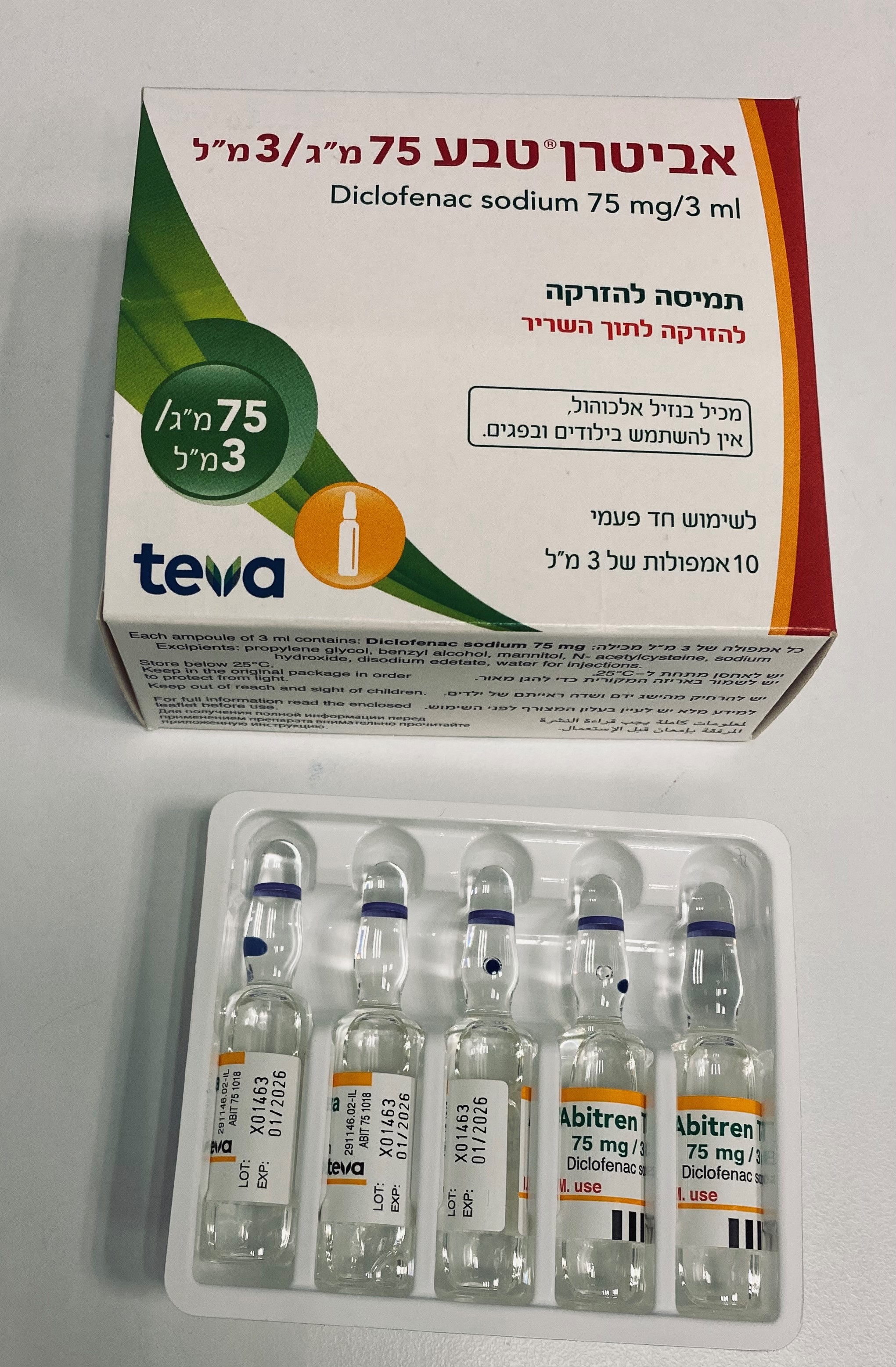Quest for the right Drug

אביטרן טבע ® 75מ"ג/3 מ"ל ABITREN TEVA ® 75 MG/3 ML (DICLOFENAC SODIUM)
תרופה במרשם
תרופה בסל
נרקוטיקה
ציטוטוקסיקה
צורת מתן:
תוך-שרירי : I.M
צורת מינון:
תמיסה להזרקה : SOLUTION FOR INJECTION
עלון לרופא
מינוניםPosology התוויות
Indications תופעות לוואי
Adverse reactions התוויות נגד
Contraindications אינטראקציות
Interactions מינון יתר
Overdose הריון/הנקה
Pregnancy & Lactation אוכלוסיות מיוחדות
Special populations תכונות פרמקולוגיות
Pharmacological properties מידע רוקחי
Pharmaceutical particulars אזהרת שימוש
Special Warning עלון לרופא
Physicians Leaflet
Pharmacological properties : תכונות פרמקולוגיות
Pharmacodynamic Properties
5.1 Pharmacodynamic properties Pharmacotherapeutic group Nonsteroidal anti-inflammatory drugs (NSAIDs). Mechanism of action Abitren Teva 75mg/3 ml is a nonsteroidal agent with marked analgesic/anti- inflammatory properties. It is an inhibitor of prostaglandin synthetase (cyclooxygenase). Diclofenac sodium in vitro does not suppress proteoglycan biosynthesis in cartilage at concentrations equivalent to the concentrations reached in human beings. When used concomitantly with opioids for the management of post-operative pain, Abitren Teva 75mg/3 ml often reduces the need for opioids.
Pharmacokinetic Properties
5.2 Pharmacokinetic properties Absorption After administration of 75mg diclofenac by intramuscular injection, absorption sets in immediately, and mean peak plasma concentrations of about 2.558 ± 0.968 µg/ml (2.5 µg/mL = 8 µmol/L) are reached after about 20 minutes. The amount absorbed is in linear proportion to the size of the dose. Bioavailability The area under the concentration curve (AUC) after intramuscular administration is about twice as large as it is following oral or rectal administration as this route avoids "first-pass" metabolism. Distribution The active substance is 99.7% protein bound, mainly to albumin (99.4%). Diclofenac enters the synovial fluid, where maximum concentrations are measured 2-4 hours after the peak plasma values have been attained. The apparent half-life for elimination from the synovial fluid is 3-6 hours. Two hours after reaching the peak plasma values, concentrations of the active substance are already higher in the synovial fluid than they are in the plasma and remain higher for up to 12 hours. Diclofenac was detected in a low concentration (100 ng/mL) in breast milk in one nursing mother. The estimated amount ingested by an infant consuming breast milk is equivalent to a 0.03 mg/kg/day dose (see section 4.6 Pregnancy and lactation). Metabolism Biotransformation of diclofenac takes place partly by glucuronidation of the intact molecule, but mainly by single and multiple hydroxylation and methoxylation, resulting in several phenolic metabolites, most of which are converted to glucuronide conjugates. Two phenolic metabolites are biologically active, but to a much lesser extent than diclofenac. Elimination Total systemic clearance of diclofenac in plasma is 263 ± 56 mL/min (mean value ± SD). The terminal half-life in plasma is 1-2 hours. Four of the metabolites, including the two active ones, also have short plasma half-lives of 1-3 hours. About 60% of the administered dose is excreted in the urine in the form of the glucuronide conjugate of the intact molecule and as metabolites, most of which are also converted to glucuronide conjugates. Less than 1% is excreted as unchanged substance. The rest of the dose is eliminated as metabolites through the bile in the faeces. Characteristics in patients Elderly: No relevant age-dependent differences in the drug's absorption, metabolism or excretion have been observed, other than the finding that in five elderly patients, a 15 minute I.V. infusion resulted in 50% higher plasma concentrations than expected with young healthy subjects. Patients with renal impairment: In patients suffering from renal impairment, no accumulation of the unchanged active substance can be inferred from the single-dose kinetics when applying the usual dosage schedule. At a creatinine clearance of <10 mL/min, the calculated steady-state plasma levels of the hydroxy metabolites are about 4 times higher than in normal subjects. However, the metabolites are ultimately cleared through the bile. Patients with hepatic disease: In patients with chronic hepatitis or non-decompensated cirrhosis, the kinetics and metabolism of diclofenac are the same as in patients without liver disease.

שימוש לפי פנקס קופ''ח כללית 1994
לא צוין
תאריך הכללה מקורי בסל
לא צוין
הגבלות
לא צוין
מידע נוסף
